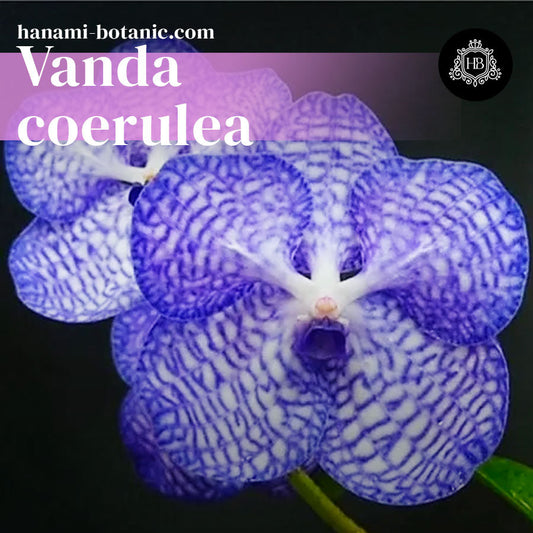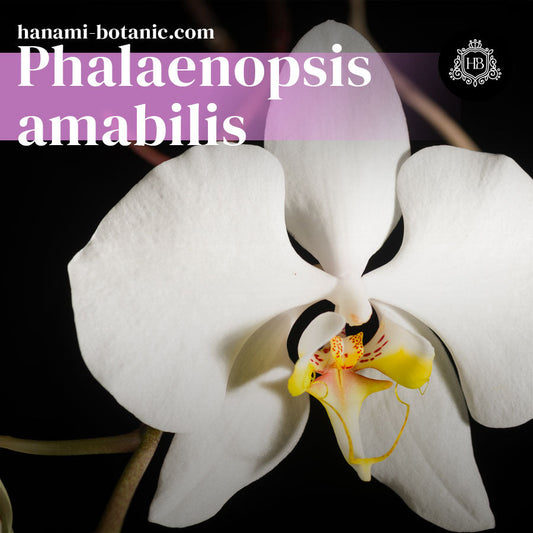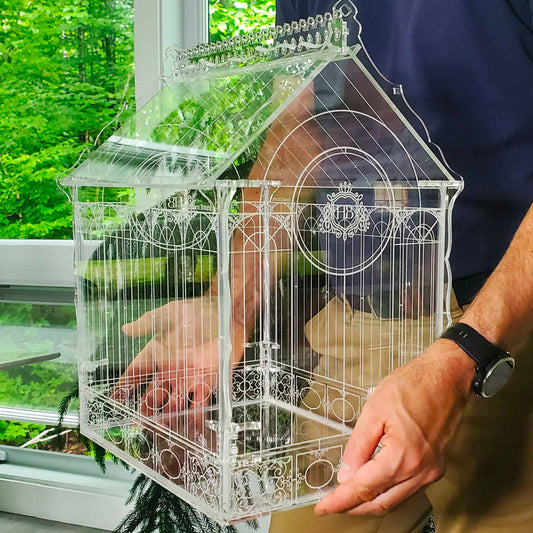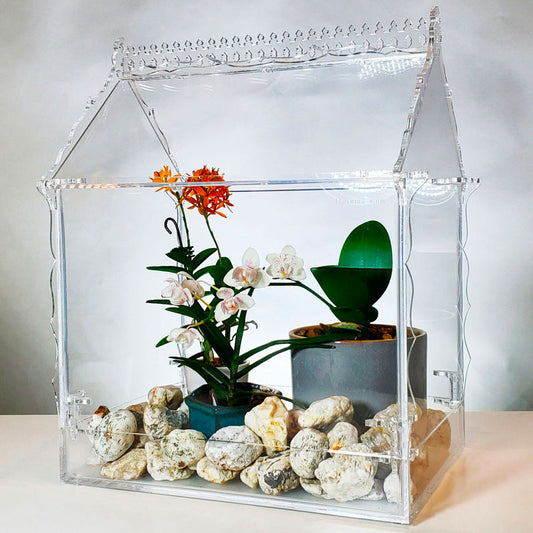Paphiopedilum concolor - Care + Growth
Christian St-PierrePaphiopedilum concolor, commonly known as the Concolor Venus Slipper, is a remarkable orchid known for its delicate flowers and elegant patterns.
What sets this orchid apart is its ability to produce almost uniformly colored flowers, giving it a unique elegance.
Why do I love it? For its subtle yet captivating flowers and ease of cultivation for orchid enthusiasts.

Where to buy Paphiopedilum concolor?Although this orchid can be challenging to find, it is sometimes available on specialized sites. You can check these sources to find Paphiopedilum concolor:
Check these sites regularly to add this beautiful orchid to your collection. |
Origin and history
Paphiopedilum concolor originates from Southeast Asia, particularly Thailand, Myanmar, and Vietnam.
It grows in shaded forests and on limestone cliffs. Discovered in the 19th century, this orchid quickly gained popularity due to its distinctive flowers and robust nature.

How to grow Paphiopedilum concolor: Care guide
Summary
- Scientific Name and Family: Paphiopedilum concolor, Orchidaceae
- Type of Plant: Terrestrial orchid
- Light: Moderate to low light, no direct sunlight
- Day/Night Temperature: 20-26°C (68-78°F) during the day, 15-18°C (59-64°F) at night
- Watering: Regularly, keeping the substrate slightly moist
- Humidity: 50-70%
- Substrate: Well-draining terrestrial orchid mix
- Fertilization: Monthly with a balanced orchid fertilizer
- Growth: Moderate, typically blooming in late winter or early spring

How to reflower Paphiopedilum concolor
To reflower Paphiopedilum concolor, it's essential to maintain a significant temperature difference between day and night.
Contrary to popular belief, it's not just fertilization that stimulates flowering but these temperature variations.
Ensure the plant also receives sufficient light without direct sunlight. Personally, I use specific LED grow lights to provide the optimal light spectrum needed for flowering.
Varieties and similar plants
Explore other varieties of Paphiopedilum and similar orchids, such as:
These varieties share similar growing conditions and are equally captivating.
FAQ about Paphiopedilum concolor
FAQ // Does one absolutely need an orchidarium or a Wardian case to grow a Paphiopedilum concolor?
No, an orchidarium or a Wardian case is not absolutely necessary to grow a Paphiopedilum concolor. This species of orchid is quite adaptable and can thrive in typical indoor conditions if provided with proper care. While an orchidarium or Wardian case can offer controlled conditions that may enhance growth and blooming, it is entirely possible to grow this orchid successfully without one.
However, for those who own multiple orchids, especially more demanding species, considering an orchidarium or Wardian case can be very beneficial. These enclosures provide several advantages:
- Controlled Environment: They maintain consistent humidity, temperature, and light levels, creating an optimal microclimate that can reduce stress on the plants and promote healthier growth.
- Protection from Pests: Orchidariums and Wardian cases can offer protection from common household pests and environmental contaminants that might otherwise affect the orchids.
- Aesthetic Appeal: Victorian-style Wardian cases are not only functional but also add a beautiful and elegant touch to your home decor. They create a stunning visual centerpiece that showcases your orchids in a unique and attractive way.
- Convenience: Having a dedicated space for your orchids can simplify care routines, making it easier to monitor and maintain the conditions your plants need to thrive.
If you have a growing collection of orchids or wish to create an ideal environment for your more challenging plants, investing in an orchidarium or a Wardian case can be a wise decision. These enclosures provide both practical benefits and aesthetic value, enhancing the overall orchid-growing experience.
Discover my handcrafted Wardian Cases
FAQ // Is Paphiopedilum concolor difficult to maintain?
It is quite robust and can thrive with proper care. Ensure you maintain consistent humidity and temperature.
FAQ // How do I care for a Paphiopedilum concolor orchid?
Provide moderate to low light, maintain humidity at 50-70%, water regularly to keep the substrate slightly moist, and use a well-draining terrestrial orchid mix. Fertilize monthly with a balanced orchid fertilizer.
FAQ // What kind of light does Paphiopedilum concolor prefer?
Natural light
Paphiopedilum concolor thrives in bright, indirect light. Ideally:
- East or west exposure: Gentle morning or afternoon light.
- Filtered light: Use sheer curtains to filter direct rays.
- Intensity: 10,000 to 15,000 lux.
LED light
LEDs are effective for these orchids:
- Full spectrum: Grow LEDs with a balanced spectrum, including blue and red spectrums.
- Intensity: 1,500 to 3,000 lumens per square foot.
- Distance: 30-40 cm above the plant.
- Duration: 12 to 14 hours per day, using a timer.
Paphiopedilum concolor needs bright, indirect light, whether natural or LED, for optimal growth and flowering.
FAQ // What is the best method for watering Paphiopedilum concolor?

Paphiopedilum concolor is an orchid that prefers consistent moisture without being waterlogged. Here are the best methods for watering this orchid:
Soaking method
- Description: Place the orchid pot in a container of water so that the water reaches about halfway up the pot for 10 to 15 minutes.
- Advantages: Ensures complete hydration of the roots without fully saturating the substrate.
- Disadvantages: Risk of root rot if water stagnates in the pot after soaking.
Overhead watering
- Description: Slowly pour water over the substrate until it is thoroughly wet.
- Advantages: Easy control of the amount of water applied.
- Disadvantages: May require more time and attention to avoid stagnant water in the saucer.
Immersion watering
- Description: Fully submerge the pot in a container of water for a few minutes, then allow it to drain thoroughly.
- Advantages: Provides quick and complete hydration of the roots and substrate.
- Disadvantages: Can be impractical for large collections of orchids.
Humidity tray
- Description: Place the pot on a tray filled with pebbles and water without the bottom of the pot touching the water directly.
- Advantages: Increases humidity around the plant without directly wetting the roots.
- Disadvantages: Does not replace direct watering but helps maintain a humid environment.
Specific tips for Paphiopedilum concolor
- Frequency: Water when the top inch of the substrate feels dry. This orchid prefers to stay consistently moist but not soggy.
- Water quality: Use rainwater, distilled water, or reverse osmosis water to avoid mineral deposits that can damage sensitive roots.
- Drainage: Use a pot with excellent drainage to prevent stagnant water, which can cause root rot.
- Humidity: Maintain moderate ambient humidity, ideally between 50% and 70%. An ultrasonic humidifier or a humidity tray can help achieve these levels, especially in winter.
By following these watering methods and tips, you can ensure that your Paphiopedilum concolor remains healthy and vibrant.

Detailed Care Guide for Paphiopedilum concolor
Type of Plant
Paphiopedilum concolor is a terrestrial orchid, naturally growing on forest floors and limestone cliffs.
Light
Moderate to low light is ideal. I use LED grow lights specifically designed for plants, providing the necessary light spectrum without the risk of leaf burn.
Temperature
Maintain daytime temperatures between 20-26°C (68-78°F) and nighttime temperatures between 15-18°C (59-64°F) to mimic its natural environment.
Watering
Water regularly to keep the substrate slightly moist. Avoid letting the substrate dry out completely between waterings.
Humidity
Keep humidity levels between 50-70%. I use a humidifier in my growing area to maintain these levels, especially during the dry winter months.
Substrate
A well-draining terrestrial orchid mix is essential. I recommend a mix of coconut fiber, perlite, and sphagnum moss.
Fertilization
For Paphiopedilum concolor, I use a specific orchid fertilizer, such as the MSU (Michigan State University) formula. This provides a balanced nutrient mix, promoting healthy growth and vibrant blooms.
- MSU Fertilizer: Optimal balance of essential nutrients
- Water pH: Maintain between 5.5-6.5 for nutrient absorption
- Silicon: Strengthens plant cells, enhancing disease resistance
- Fresh Seaweed: Natural source of micronutrients and phytohormones
- Superthrive: Vitamin supplement to reduce plant stress and stimulate growth
These products, used together, create an ideal nutritional environment for Paphiopedilum concolor, ensuring vigorous growth and spectacular blooms.
Growth
Paphiopedilum concolor has moderate growth, with blooms often appearing in late winter or early spring.
Consistent care and the right conditions will reward you with its elegant and long-lasting flowers.

I'm Christian. Passionate about orchids and terrariums for many years, I share my botanical adventures, practical advice, and personal anecdotes.
I also create terrarium-style mini greenhouses to help your orchids thrive. Feel free to contact me—I’d be happy to help you on this beautiful botanical journey.
References
Conclusion
I hope this detailed guide on Paphiopedilum concolor inspires you to enrich your orchid collection and explore the wonders of growing plants in mini-greenhouses.













2 comments
Hi Emily,
Thanks for reaching out and for your kind words! Getting a Paphiopedilum concolor to bloom can sometimes be a bit tricky, even when the plant looks healthy. Here are a few tips:
Try creating a temperature difference between day and night. During the day, aim for 72-75°F and at night, around 60-65°F. Sometimes, this little temperature shift can trigger blooming.
Next, make sure your plant is getting the right nutrients. Every week, I soak my orchids for 15 minutes in a solution of silicon, MSU fertilizer, fresh algae (halved dosage), and Superthrive, with the pH adjusted to 5.8. This really helps keep them healthy and ready to bloom.
Keep providing bright, indirect light and watering regularly to keep the substrate slightly moist. With a bit of patience and these adjustments, your Paphiopedilum concolor should start blooming soon. Let me know how it goes!
Christian
I’ve been growing a Paphiopedilum concolor for a few months, and while it seems healthy, it hasn’t bloomed yet. I’ve adjusted the light and watering according to your recommendations, but still no flowers. Are there specific conditions or nutrients needed to encourage this orchid to bloom?
Thanks for your help!